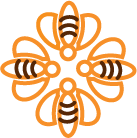We are incredibly lucky to be living in New Mexico right now. Les Crowder and Heather Harrell from Northern NM have just published their book, “Top Bar Beekeeping.” Go out, grab a copy and try and attend one of the book signings! You can find the book at: http://www.fortheloveofbees.com/topbar-beekeeping-book/
“As beekeepers, we are intimately tied to our environment and the symptoms of its degradation. … Without pollinators, our current population cannot survive and, similarly, without our support and protection, pollinators cannot survive.” — fromTopbar Beekeeping
Reviews:
“This is an excellent guide for hobby beekeepers who wish to keep bees using top-bar hives. Drawing on his more than 30 years of beekeeping experience in New Mexico, author Les Crowder describes in detail the special comb management techniques that this low-cost, but relatively intensive, form of beekeeping requires. Top-Bar Beekeeping also provides an eloquent appeal for beekeepers to make care, respect, and reverence the foundation of their relationships with the bees.” — Thomas D. Seeley, Cornell University; author of Honeybee Democracy and The Wisdom of the Hive
“Reading Top-Bar Beekeeping reminds me of the classes I took with Les Crowder several years ago. He’s a man who truly knows whereof he speaks, who has the gift of communicating with his small friends, the bees, and sharing his understanding with us. . . . This is the one book on beekeeping that I will recommend to my permaculture students.” — Scott Pittman, Director, Permaculture Institute USA
Cave drawings show beekeepers “smoking” their hives, preparing for insect interaction. Today’s mass-produced honey relies mostly on the venerable Langstroth method of beekeeping, which has produced plenty of honey—but also has introduced plenty of chemicals into the process—through the years. Top-bar hives, named for the bars that run across their tops, are popular with bee beginners even though they produce less honey than Langstroth hives. But this account, the culmination of Crowder and Harrell’s 40 years of top-bar beekeeping adventures, shows the reader their method’s advantages: it avoids antibiotics, miticides, and other chemicals inherent to the conventional process. Crowder and his wife, Harrell, leave no comb unharvested as they take the top-bar aspirant from bee basics (stings, smoke, and hive transfers) through hive management (comb removal and feeding) to beneficial, and profitable, byproducts like beeswax. For those a bit lukewarm to the swarm, the book gives a fascinating insight into bees’ elaborate organizational and geometry skills, and it may even make one reconsider buying mass-marketed, chemical-laced honey.
(Sept. 15)- Publisher’s Weekly
From the back cover:
Beekeepers continue to face tremendous challenges, from pests such as varroa and tracheal mites and, in recent years, from the mysterious but even more devastating phenomenon known as Colony Collapse Disorder (CCD). Yet in backyards and on rooftops all over the world, bees are being raised successfully, even without antibiotics, miticides, or other chemical inputs, through the use of topbar hives.
Long lasting and completely biodegradable, a topbar hive made of untreated wood allows bees to build comb naturally rather than simply filling prefabricated foundation frames in a typical Langstroth box hive with supers. Regular hive inspection and the removal of old combs helps to keep bees healthier and naturally free of disease, and is one of many reasons why more and more organically minded beekeepers are using topbar hives.
Topbar Beekeeping provides readers with all they need to know to get started in using these innovative hives, as well providing a primer on natural hive management. The book also includes overviews of hive characteristics, raising queens, tips on handling the extra beeswax and, perhaps most importantly, planting for pollinators.
The natural, low-stress methods outlined Topbar Beekeeping are perfect for home and hobbyist beekeepers who have the time and interest in keeping bees intensively. It will also appeal to home orchardists, gardeners, and permaculture practitioners who look to bees for pollination as well as honey or beeswax.

